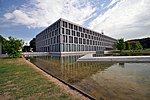University of Erfurt

The University of Erfurt (German: Universität Erfurt) is a public university located in Erfurt, the capital city of the German state of Thuringia. It was founded in 1379, and closed in 1816. It was re-established in 1994, three years after German reunification. Therefore it claims to be both the oldest and youngest university in Germany. The institution identifies itself as a reform university, due to its most famous alumnus Martin Luther, the instigator of the Reformation, who studied there from 1501 to 1505. Today, the main foci centre on multidisciplinarity, internationality, and mentoring. The university is home to the Max Weber Center for Advanced Cultural and Social Studies, the Gotha Research Center for Cultural and Social Scientific Studies, and the Willy Brandt School of Public Policy. The Gotha Research Library, which has one of Germany's largest collections of early modern manuscripts, is part of the university. The University Library is also the keeper of the Bibliotheca Amploniana, a collection of nearly 1000 medieval manuscripts collected by the scholar Amplonius Rating de Berka (c.1363–1435), who was a former Rector of the university.
Excerpt from the Wikipedia article University of Erfurt (License: CC BY-SA 3.0, Authors, Images).University of Erfurt
Nordhäuser Straße, Erfurt Andreasvorstadt
Geographical coordinates (GPS) Address Website External links Nearby Places Show on map
Geographical coordinates (GPS)
| Latitude | Longitude |
|---|---|
| N 50.990555555556 ° | E 11.010833333333 ° |
Address
Universität Erfurt
Nordhäuser Straße 63
99089 Erfurt, Andreasvorstadt
Thuringia, Germany
Open on Google Maps









